Characteristics
Stable isotopes are non-radioactive atoms of a particular chemical element which have the same number of protons but different number of neutrons. The relative abundance of the heavy compared with the light isotope (e.g. 13C/12C) is given the name isotopic signature or fingerprint and is represented by a delta symbol (δ) by means of the ratio of this proportion in the sample, with respect to international standards, giving the results in units per thousand (‰).
The Doñana Biological Station (EBD) Stable Isotope Laboratory (LIE) is equipped with a Mass Spectrometry system, supplied by Thermo Fisher Scientific, to measure the isotope ratios 13C/12C, 15N/14N, 18O/16O, 34S/32S and 2H/1H in organic and inorganic, solid or liquid samples.
This Laboratory was founded thanks to funding from the project: “Adapting to Global Change in the Mediterranean hotspot: from genes to ecosystems (EcoGenes)”.
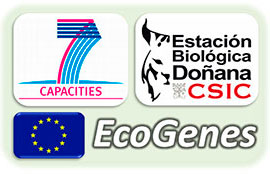
Here we give you a virtual tour of the EBD, funded through EcoGenes, in which you can see all the laboratories including the LIE.
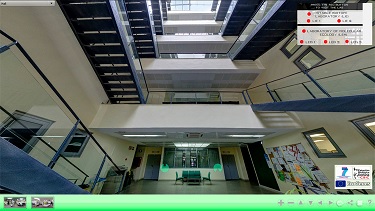
Equipment
DELTA V Advantage IRMS in continuous flow mode, with a system of 5 collectors for measuring isotopic ratios in N2, CO, NO, O2, CO2, N2O, SO2 and H2.
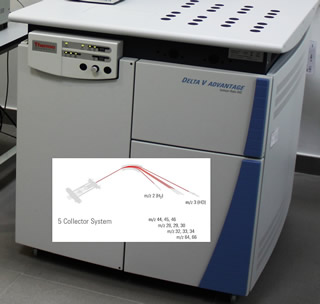
Flash HT Plus Elemental Analyzer connected to an IRMS via the Conflo IV. With two furnaces installed for two modes of operation: “Dynamic Flash Combustion” for isotopic analysis of C, N and S; and “High Temperature Conversion” for isotopic analysis of O and H.
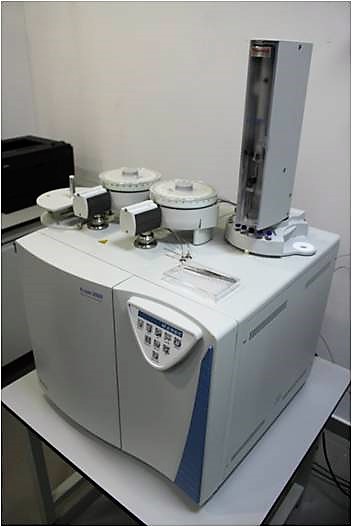
Picarro L2130-i CRDS (Cavity Ring Down Spectroscopy) Laser Spectrometer for continuously measuring the stable isotopes of Hydrogen and Oxygen in water and water vapour.
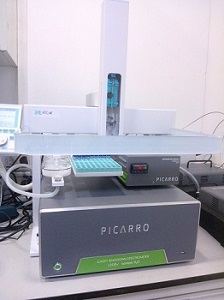
GasBench II Universal on-line gas preparation system. The GasBench II system provides high-precision on-line isotope and molecular ratio determination of headspace gas, including water equilibration, carbonates, and atmospheric gases (e.g. CO2, O2/N2). A series of nafion traps remove water and a GC column separates gases in time for analysis of isotopic composition largely free of interference. This system is able to attain nearly the precision and accuracy of a dual inlet system on a continuous-flow IRMS system.

Contiunous flow mass spectrometry system (GC-MS-IRMS) for the automated measurement of isotopic ratios of carbon, nitrogen and hydrogen in specific compounds.
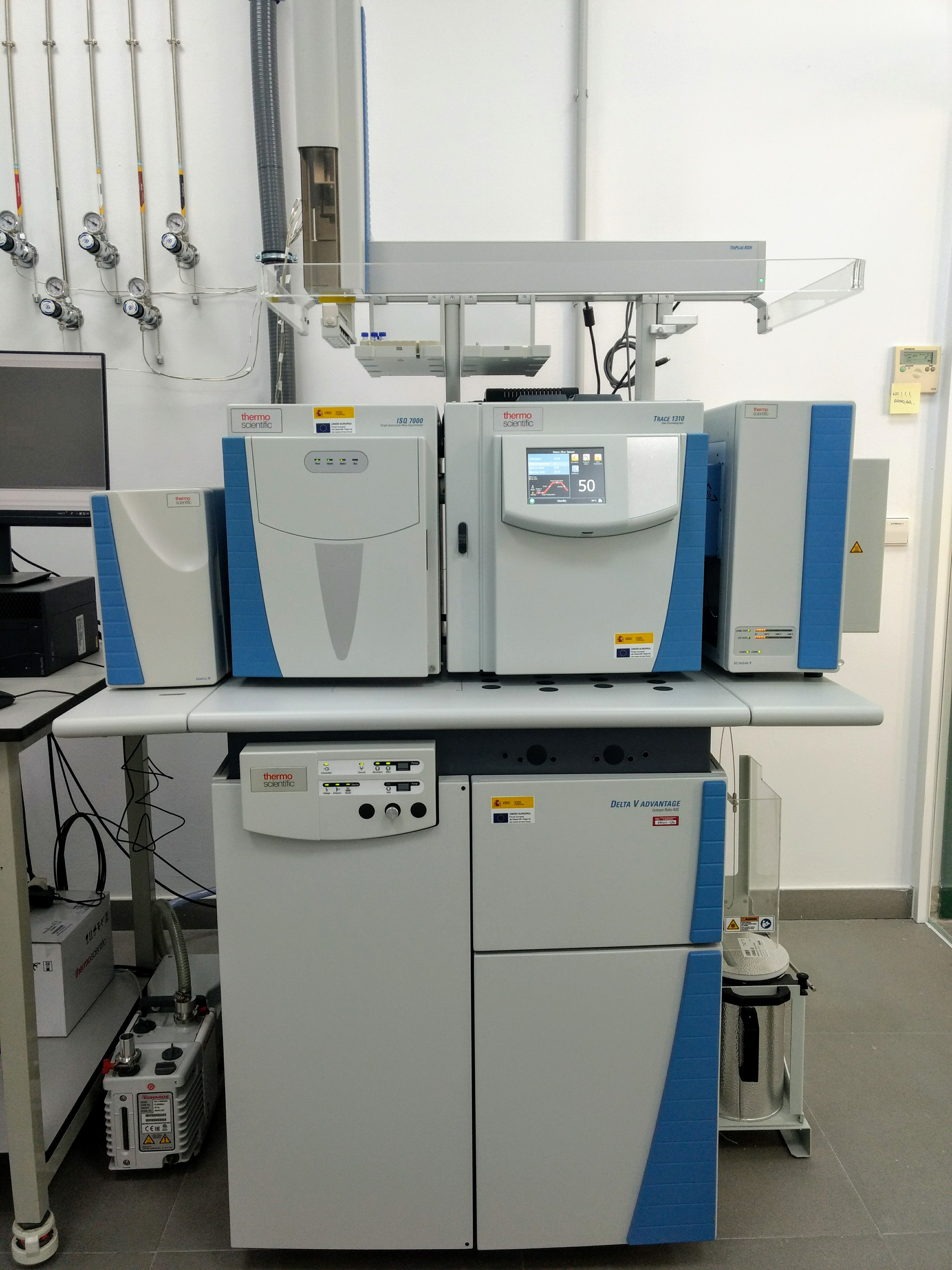

Latest News
New paper! Romero-Vidal P, Luna A, Fernández-Gómez L, Navarro J, Palma A, Tella JL, Carrete M (2023) Intraspecific competition and individual behaviour but not urbanization affect the dietary patterns of a generalist avian predator. Scientific Reports 13:10255
New paper! Elias-Valdez A, Velarde E, Medina-Quej A, Castro-Pérez JM, Navarro J, Rosas-Luis R (2023) Feeding ecology of Heermann’s Gull (Larus heermanni) and Elegant Tern (Thalasseus elegans) chicks coexisting on Isla Rasa, Gulf of California, based on stable isotope measurements. Marine Ecology Progress Series 712 101–111
New paper! Vez-Garzón M, Giménez J, Sánchez-Márquez A, Montalvo T, Navarro J (2023) Changes in the feeding ecology of an opportunistic predator inhabiting urban environments in response to COVID-19 lockdown. Royal Society Open Science 10: 221639
New paper! Riesgo L, Sanpera C, García-Barcelona S, Sánchez-Fortún M, Coll M, Navarro J (2023) Understanding the role of ecological factors affecting mercury concentrations in the blue shark (Prionace glauca). Chemosphere 313: 137642
New paper! Sánchez-Márquez A, Navarro J, Kaliontzopoulou A, Farré M, Taite M, Escolar O, Villanueva R, Allcock L, Fernández-Álvarez FA (2023) Unravelling the phylogenetic and ecological drivers of beak shape variability in cephalopods. Reviews in Fish Biology and Fisheries 33, 221–239
New paper!: Vidal (2023) The relative importance of biological and environmental factors on the trophodynamics of a pelagic marine predator, the blue shark (Prionace glauca)
New paper!: Vigo (2022) Using molecular and stable isotope markers to identify the main predators of Nephrops norvegicus in Mediterranean deep-water ecosystems
New paper!: Quillfeldt (2022) Variation Among Species and Populations, and Carry-Over Effects of Winter Exposure on Mercury Accumulation in Small Petrels
New paper!: Bertolero (2022) Identifying potential predators of the apple snail in the most important invasion area of Europe
4th STABLE ISOTOPE COURSE IN ECOLOGY AND ENVIRONMENTAL SCIENCES. 22 - 25 February 2022.
New paper!: Mir-Arguimbau J, Olivar MP, Raya V, Navarro J, Sabatés A (2021) Trophic links between blue whiting (Micromesistius poutassou) larvae and the winter planktonic community in the NW Mediterranean Sea. Marine Ecology Progress Series 670:185-2021
New paper!: Arrondo E, Navarro J, Perez-García JM, Mateo R, Camarero PR, Martin-Doimeadios RCR, Jiménez-Moreno M, Cortés-Avizanda A, Navas I, García-Fernández AJ, Sánchez-Zapata JA, Donázar JA (2020) Dust and bullets: stable isotopes and GPS tracking disentangle lead sources for a large avian scavenger. Environmental Pollution 266, 115022
New paper!: Pascual-Rico R, Sánchez-Zapata JA, Navarro J, Eguía S, Anadón JD, Botella F (2020) Ecological niche overlap between co-occurring native and exotic ungulates: insights for a conservation conflict. Biological Invasions 22, 2497–2508
New paper!: Gordo G. (2020) Stable hydrogen isotope measurements of songbird feathers: effects of intra-feather variability and sample processing
New paper!: Sleeping with the enemy: unravelling the symbiotic relationships between the scale worm Neopolynoe chondrocladiae (Annelida: Polynoidae) and its carnivorous sponge hosts
New paper!: Carboxylesterase activities as potential biomarkers of pollution in marine pelagic predators
New paper!: Interannual trophic behaviour of a pelagic fish predator in the western Mediterranean Sea
New paper!: Ecological niche overlap between co-occurring native and exotic ungulates: insights for a conservation conflict
New paper!: Trophic strategies of three predatory pelagic fish coexisting in the north-western Mediterranean Sea over different time spans
New paper!: Feeding ecology of blue whiting (Micromesistius poutassou) in the NW
Mediterranean: The important role of Myctophidae
New paper!: The Seasonal Distribution of a Highly Commercial Fish Is Related to Ontogenetic Changes in Its Feeding Strategy
New paper!: Potentially handicapped but otherwise functional: Malformations in prey capture tools show no impacts on octopus life
New paper!: Feeding ecology of a Mediterranean endemic mesopredator living in highly
exploited ecosystems
New paper!: Within-individual phenotypic plasticity in flowers fosters pollination niche shift
New paper!: Lopezosa P, Forero MG, Ramirez F, Navarro J (2019) Individuals within populations: no evidences of individual specialization in the trophic habits of an opportunistic predator. Estuarine, Coastal and Shelf Science 229, 106427
*Master-student **Corresponding author
New paper!: Albo-Puigserver M, Borme D, Coll M, Tirelli V, Palomera I, Navarro J (2019) Trophic ecology of range-expanding round sardinella and resident sympatric species in the NW Mediterranean. Marine Ecology Progress Series 620, 139–154 *Phd-Student
New paper!: Yemisken E, Navarro J, Forero MG, Megalofonou P, Eryilmaz L (2019) Trophic partitioning between abundant demersal sharks coexisting in the North Aegean Sea. Journal of the Marine Biological Association of the United Kingdom 99, 1213-1219
Research report 2018 published Report LIE 2018
New paper!: Seabird plastic ingestion differs among collection methods: Examples from the short-tailed shearwater
New paper!: Impact of dredged-material disposal on soft-bottom communities in a recurrent marine dumping area near to Guadalquivir estuary, Spain
New paper!: Maintenance dredging impacts on a highly stressed estuary (Guadalquivir estuary): A BACI approach through oligohaline and polyhaline habitats
New paper!: Towards the identification of ecological management units: A multidisciplinary approach for the effective management of bottlenose dolphins in the southern Iberian Peninsula
New paper!: Living apart together: Niche partitioning among Alboran Sea cetaceans
STABLE ISOTOPE COURSE IN ECOLOGY AND ENVIRONMENTAL SCIENCES
New paper!: A native bird as a predator for the invasive apple snail, a novel rice field invader in Europe
New Paper!: Tracking data and retrospective analyses of diet reveal the consequences of loss of marine subsidies for an obligate scavenger, the Andean condor
Research report 2017 published Report LIE 2017
New Paper!: Feeding ecology of Mediterranean common dolphins: The importance of mesopelagic fish in the diet of an endangered subpopulation
New Paper!: Diet of bottlenose dolphins (Tursiops truncatus) from the Gulf of Cadiz: Insights from stomach content and stable isotope analyses
New Paper!: Trophic habits of an abundant shark in the northwestern Mediterranean Sea using an isotopic non-lethal approach
New laboratory e-mail: lie@ebd.csic.es, for any request!
2017 New analysis fees published on "Services" tab: New Fees
New Paper!: Feeding ecology and trophic relationships of pelagic sharks and billfishes coexisting in the central eastern Pacific Ocean
New Paper!: Feeding habits of three Batoids in the Levantine Sea (north-eastern Mediterranean Sea) based on stomach content and isotopic data
New Paper!: Lipid effects on isotopic values in bottlenose dolphins (Tursiops truncatus) and their prey with implications for diet assessment
Breaking news!: Why we need a centralized repository for isotopic data (Read more)
Research report 2016 published Report 2016
New Paper!: Intra- and interspecific niche partitioning in striped and common dolphins inhabiting the southwestern Mediterranean Sea
New scientific project: Understanding trophic ecology of the California kingsnake, a new invasive species in Gran Canaria (Canary Islands, Spain)
New Paper!: Feeding ecology of two demersal opportunistic predators coexisting in the northwestern Mediterranean Sea
New Paper!: Assessing the trophic ecology of three sympatric squid in the marine ecosystem off the Patagonian Shelf by combining stomach content and stable isotopic analyses
An online temperature-controlled vacuum equilibration preparation system for the measurement of δ2H values of nonexchangeable-H and of δ18O values in organic materials by isotope-ratio mass spectrometry (Read more)








